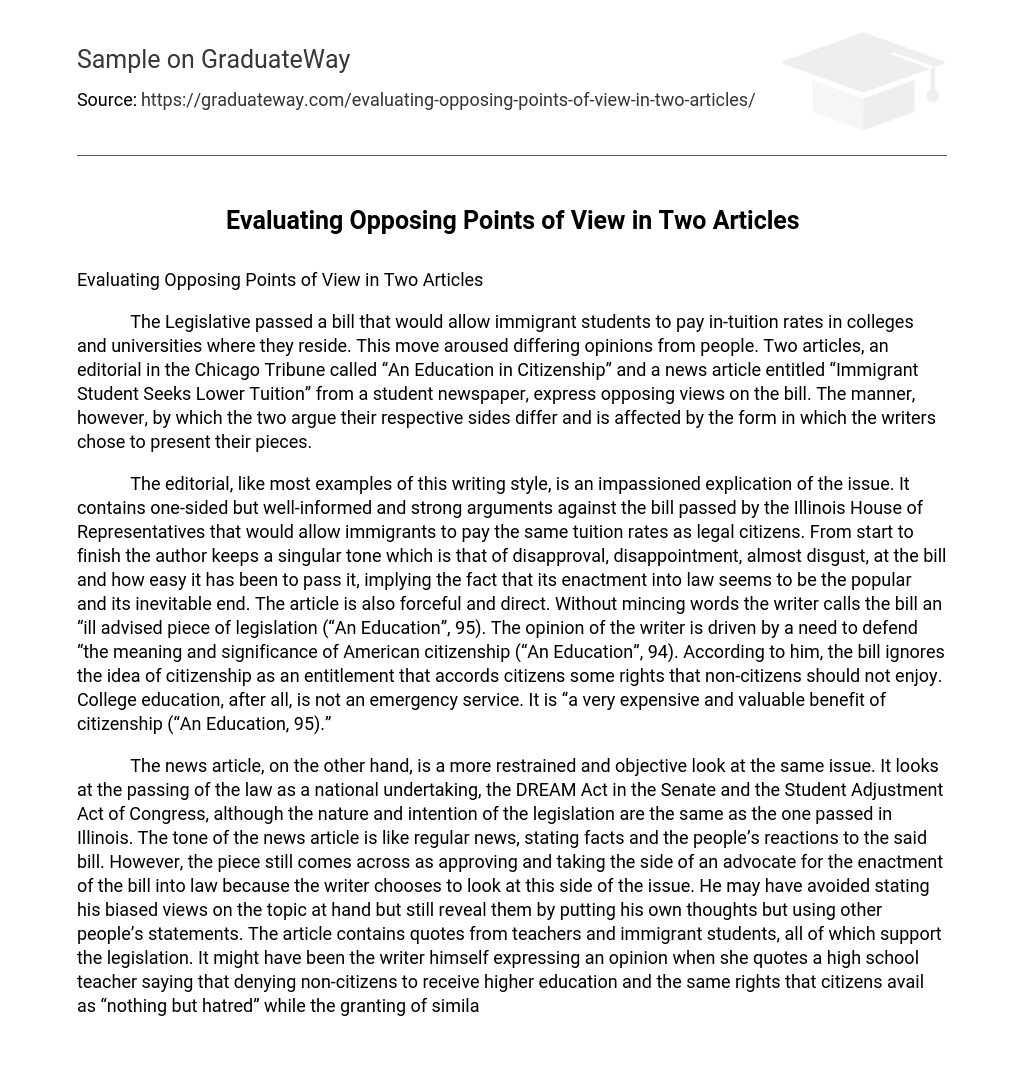The Legislative passed a bill that would allow immigrant students to pay in-tuition rates in colleges and universities where they reside. This move aroused differing opinions from people. Two articles, an editorial in the Chicago Tribune called “An Education in Citizenship” and a news article entitled “Immigrant Student Seeks Lower Tuition” from a student newspaper, express opposing views on the bill. The manner, however, by which the two argue their respective sides differ and is affected by the form in which the writers chose to present their pieces.
The editorial, like most examples of this writing style, is an impassioned explication of the issue. It contains one-sided but well-informed and strong arguments against the bill passed by the Illinois House of Representatives that would allow immigrants to pay the same tuition rates as legal citizens. From start to finish the author keeps a singular tone which is that of disapproval, disappointment, almost disgust, at the bill and how easy it has been to pass it, implying the fact that its enactment into law seems to be the popular and its inevitable end. The article is also forceful and direct. Without mincing words the writer calls the bill an “ill advised piece of legislation (“An Education”, 95). The opinion of the writer is driven by a need to defend “the meaning and significance of American citizenship (“An Education”, 94). According to him, the bill ignores the idea of citizenship as an entitlement that accords citizens some rights that non-citizens should not enjoy. College education, after all, is not an emergency service. It is “a very expensive and valuable benefit of citizenship (“An Education, 95).”
The news article, on the other hand, is a more restrained and objective look at the same issue. It looks at the passing of the law as a national undertaking, the DREAM Act in the Senate and the Student Adjustment Act of Congress, although the nature and intention of the legislation are the same as the one passed in Illinois. The tone of the news article is like regular news, stating facts and the people’s reactions to the said bill. However, the piece still comes across as approving and taking the side of an advocate for the enactment of the bill into law because the writer chooses to look at this side of the issue. He may have avoided stating his biased views on the topic at hand but still reveal them by putting his own thoughts but using other people’s statements. The article contains quotes from teachers and immigrant students, all of which support the legislation. It might have been the writer himself expressing an opinion when she quotes a high school teacher saying that denying non-citizens to receive higher education and the same rights that citizens avail as “nothing but hatred” while the granting of similar rights as “exemplify(ing) good citizenship (as quoted in O’Connor, 96).” The article empathizes with immigrant students and the promotion of their rights as humans, regardless of the legality of their American citizenship.
The editorial form allows the writer to express his opinions without being judged as bias because the editorial is expected to be bias in the first place. The new article, though, has the burden of sounding objective even if it wants to stress one side against another. The two articles contrasted in this essay both discuss a similar issue but differ in the manner of presenting their respective arguments because of the differing forms by which each writer chose to write their pieces. Both are well-discussed, however, so that the reader who comes upon any of these articles would be convinced that the writer’s assertions are intelligently argued and are convincing enough. If he reads the news article, he may be happy about what the legislation would do to help immigrant students. If he reads the editorial, however, he may have second thoughts about supporting the said bill.
Works Cited
“An Education in Citizenship.” Now and Then. 94-95.
O’Connor, Cara. “Immigrant Students Seek Lower Tuition.” Now and Then. 96-98.





